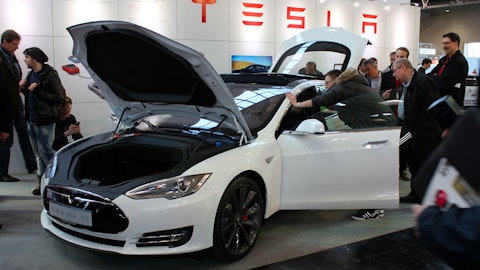Russell Clark is dubbed as the “world’s most bearish hedge fund manager” because he is not only shorting the market, he is using leverage and shorting the market at the same time. Russell Clark’s Horseman Capital returned 7.5% in 2018 when the S&P 500 Index lost nearly 5%. We shared his December 2018 investor letter (you need to create a free account to download) on our site. In that letter Clark revealed that his net US exposure was around -50% and he was most bearish about technology and financials. Clark also explained why he is shorting the defense stocks. Here is what he said:
“About one sixth of federal spending goes to national defense. Given Congressional Budget Office (CBO) forecasts that US deficits will rise from 3.9% of GDP in 2018 to 9.5% in 2048 (resulting in federal debt held by the public reaching 154% of GDP), every subset of spending makes for intriguing reading.
At the direction of the Congress, the Department of Defense (DoD) generally issues annual reports that describe its plan for building new ships over the next 30 years. CBO examines these plans in detail and estimates the cost of proposed ship purchases using its own estimation methods and assumptions. CBO also analyzes how those ship purchases would affect the Navy’s inventories of various types of ships over the next three decades.
The Department of Defense submitted the Navy’s 2019 ship building plan, which covers fiscal years 2019 to 2048, to the Congress in February 2018. The average cost of carrying out that plan over the next 30 years would be about $28.9 billion in 2018 dollars, CBO estimates.
The Navy’s 2019 shipbuilding plan differs substantially from its 2017 plan in its goal for the total inventory of battle force ships, the number and type of ships that the Navy would purchase, and the funding proposed to implement the plan. If fully carried out, the shipbuilding plan would represent the largest naval buildup since the Reagan Administration in the 1980s.
The shipbuilding plan calls for expanding the fleet to 355 battle force ships. On average, implementing the plan would cost 80 percent more per year than the funding for shipbuilding that the Navy has received in recent decades.
The Horseman Global Fund is short US defense contractors.
Given the spiraling costs above, together with CBO forecasts of mounting debts, efforts have already been made at the DoD to halt cost escalation in the defense budget. So far these have fallen mostly in areas unrelated to hardware procurement, such as military wages and R&D.
However, analysis by groups such as the Centre for Strategic & International Studies highlights that level of competition among the biggest contractors has dramatically fallen in recent years, resulting in greater profitability for the companies involved.
As highlighted in the November Market View titled, “Price War” a number of tailwinds are beginning to turn into headwinds for these companies. However, we might also add pressure from the Federal Government to scrutinize profit terms of defense contracts, in order to stabilize federal debt, to the list.”
That was in January. Now we learned that Clark dramatically increased his short exposure to -142% and his long exposure is only 31%. This means Clark’s net overall exposure currently sits at -111%.
Since we are experiencing a very strong bull market in 2019, Horseman Capital delivered a net return of -27% during the first 10 months of this year. We know that he was most bearish about technology and financial stocks. So, in this article we are going to take a look at his stock picks that he isn’t bearish about (or much less bearish about).
Technically a long position in a stock doesn’t necessarily mean that Clark is bullish about that stock. Those long positions might just be hedges. In any case, a long position in a stock is still a vote of confidence because at the very least he believes those long positions are better stock picks than his short positions.
Russell Clark had relatively very large positions in Facebook, Alphabet, and Amazon. He had $20 million invested in these three stocks. This is a large number given that his fund’s AUM is now stands at $150 million. Clark also had $3 million invested in each of Microsoft Corp (NASDAQ:MSFT) and JPMorgan Chase & Co. (NYSE:JPM). These aren’t his only large cap technology and finance holdings. He also had smaller positions in Morgan Stanley (NYSE:MS), Citigroup, Alibaba, Apple Inc. (NASDAQ:AAPL), Netflix Inc. (NASDAQ:NFLX), and even Tesla, Inc. (NASDAQ:TSLA).

Hadrian / Shutterstock.com
We know why Clark is long Tesla. Because he is betting against a basket of auto companies. So, basically he believes Tesla Inc shares will perform better than other auto stocks in a world we see large declines in stock markets across the globe.
It also seems like Clark intentionally picked the largest, relatively sturdiest technology and financial stocks almost indiscriminately. Sure, Apple Inc. (AAPL) and Microsoft Corp (MSFT) are the two largest companies in the US markets, but they didn’t get the largest allocation from Horseman Capital. Nevertheless, Horseman has long positions in all of the top 5 largest technology stocks in its portfolio. He also has long positions in 3 of the 5 most popular financial stocks among hedge funds.
Clark probably doesn’t think that these stocks have the highest upside potential and are great long-term investment ideas. You may recall that Clark’s total gross exposure was 140%. He used 100% of his capital to short a bunch of companies and then borrowed some 40% more capital to short some more. To hedge some of this additional short leveraged bets he probably bought the largest technology and finance companies that he believes will decline less than the rest of the technology and finance stocks. Incidentally, Facebook, Amazon, Microsoft Corp, Alibaba, and Alphabet are also among the top 20 most popular stocks among the 750+ hedge funds tracked by Insider Monkey. Hedge funds’ top 20 stock picks returned an average of 34.7% through November 22nd and outperformed the S&P 500 Index ETFs by 8.5 percentage points. So, Clark was actually able to generate some alpha from his long stock picks.
Basically, even the world’s most bearish hedge fund manager believes that hedge funds’ consensus technology stock picks are better bets than the rest of the technology sector. These stocks performed better than the rest of the market. Unfortunately, Clark may be completely wrong about the market or too early in his call. If he had used a market neutral investment approach where his net exposure was around zero percent, he might have not only generated positive returns (alpha) but also had more time on his side to be proven potentially right.
Disclosure: None. This article is originally published at Insider Monkey.





